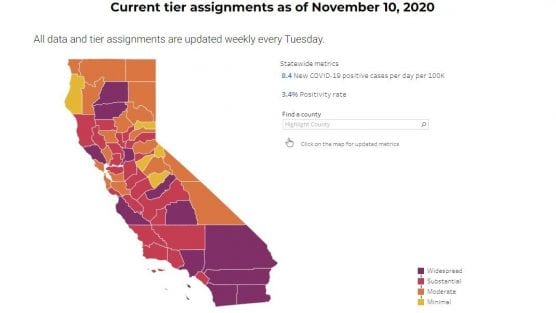It took California less than a year to reach 1 million confirmed COVID-19 cases, and as large swaths of the Golden State are steeped in widespread infection, experts say the worst is yet to come here and across the nation.
It took California about 240 days to confirm its one million cases according to various news outlets that called the tragic milestone on Thursday. California health officials reported nearly 7,000 new cases, putting the state’s official tally at 991,609 confirmed cases to date.
The California Department of Public Health says its numbers may not be a true day-over-day representation of the data because results can be delayed. It did not respond to a request for comment by press time.
Since the pandemic began in earnest in February, more than 18,000 have died in California. Nationally, the death toll stands at more than 240,000.
Like the rest of the nation, California has seen a surge in confirmed cases in recent weeks that will likely lead to more people admitted to hospitals, ICUs and could lead to more deaths.
In Los Angeles County, health officials report 1 out of every 580 residents is infectious with new daily cases topping 2,000 over the last several days. On Thursday, officials reported 7 new deaths, 2,533 new infections and health officials hinted some type of drastic change could happen if the trend continues.
“If collectively we fail to stop the acceleration of new cases, we will have no choice but to look at additional actions,” said L.A. County Public Health Director Barbara Ferrer during a Thursday briefing. “It isn’t just that our recovery journey is stalled, it’s also that we now have tough choices in front of us as we head into Thanksgiving and the winter holidays.”
The outlook is not expected to improve as COVID-19 metrics come in waves: first, the confirmed cases, which L.A. County is currently seeing, then hospitalizations, and an increase in deaths.
Based on a surge this past summer, L.A. County and the whole state could be hit by the waves.
“This information should help remind us that we most likely haven’t yet seen the full consequence of the surge in cases we recently experienced,” said Ferrer. “And while we’ve made impressive strides in caring for people who are ill with the virus, this much of an increase in cases may very well result in tremendous suffering and tragic deaths down the road.”
East of L.A., San Bernardino and Riverside counties have seen more than 70,000 confirmed cases and more than 1,000 deaths, respectively. Under the state’s tier-ranking system, all three counties remain in the most restrictive level due to the widespread infection, meaning large swaths of the economy remain closed. But L.A. County is by far the leader with cases spread across its population of 10 million — a state unto itself.
The last surge in L.A. County receded sometime in early September, weeks after public health officials closed offices, gyms, indoor malls, salons and other businesses. The hope is that L.A. County — and the rest of the state — can pull a repeat.
“I think we’re all, for the whole state, every single county, every single public health director is asking for the same: we have to get this back under control,” Ferrer said. “We know what we can do, we have the tools to do it and then we’re just going to go ahead and start working on that.”
Since mid-June, California has required anyone in public to wear a mask. But with the recent surge, it’s unclear if state health officials will institute new guidelines or lockdowns for an already virus-weary populace.
California Governor Gavin Newsom’s office did not immediately respond to request for comment, but in a tweet, Newsom said the daily case average is around 6,700 statewide and hospitalizations have seen a 36% increase along with a 37% increase of ICU admittance in recent weeks.
“We absolutely must take these increases seriously. Wear your mask. Physically distance. Do not let your guard down. Your actions could literally save lives,” Newsom wrote.
While 1 million coronavirus cases in California is an astounding figure, it’s important to put it in perspective: the United States has seen more than 1 million new COVID-19 cases in just the first 10 days of November.
Like this:
Like Loading...
Related





 Tweet This
Tweet This Facebook
Facebook Digg This
Digg This Bookmark
Bookmark Stumble
Stumble RSS
RSS


























REAL NAMES ONLY: All posters must use their real individual or business name. This applies equally to Twitter account holders who use a nickname.
0 Comments
You can be the first one to leave a comment.